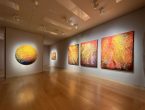At that time when everything was human
2016 - Film & Video (Film & Video)
26:00 minutes
Aline Baiana
Indigenous educator and curator Sandra Benites, of the Guarani-Ñandeva people, narrates the origin myth of the bird Urutau in her native language. This nightjar stands still on a branch all day long and, at dusk, cries a low hoot resembling a human weeping. In 2013, indigenous activist José Urutau Guajajara remained on the top of a tree for 26 hours, deprived of food and water by state forces. As if following a fate brought by his name, Urutau Guajajara bravely defied his people’s third violent eviction attempt from an urban occupation called Aldeia Maracanã (the name refers to Estádio do Maracanã, Rio de Janeiro’s biggest football stadium). Since 2006, indigenous population and social movements squatted in the abandoned building of what used to be, ironically, the “Museum of the Indian”, placed next to the arena. The site was reclaimed by the city hall and real estate developers in the context of 2014’s World Cup. At that time when everything was human by Aline Baiana conveys an immersive flow of sounds and nature imagery as well as live documentation from the eviction cuts in, changing the film’s atmosphere entirely. With this twist, Baiana overlaps two narratives of neglect: the Guaraní Nhandeva myth – where a father abandons his first partner pregnant with twins – and the indigenous populations deliberately left in the State’s margins. The title refers to a mythological time before the species’ differentiation and, at the same time, ironizes the ‘inhuman’ treatment the activists get from the local authorities and Rio de Janeiro’s police.
Aline Baiana’s work is informed by extensive theoretical and field research on indigenous, feminist, ethnic, environmental, and social justice matters. Her films, sculptures, and installations often draw from personal and collective memories to unveil the entrenched effects of an extrativist colonial mentality ever-present in her native Brazil and most Latin America. Aline claims that “Being Latin American and, more specifically, black and Brazilian, makes any separation between art and politics impossible”. From this standpoint, she often tackles pressing issues such as environmental crimes and social injustices, such as the Samarco mining waste dam collapse in 2015 , the impacts of hydroelectric power stations in riverine villages and president Dilma Roussef’s parliamentary coup in 2016. Baiana usually works closely with local communities and incorporates a plurality of visions into her practice, leading to multilayered and often poetic approaches to sociopolitical conflicts.
Colors:
Related works sharing similar palette
» see more

© » STEVE LAMBERT
The Utopia Project at Smithsonian Anacostia Community Museum - Steve Lambert The Utopia Project at Smithsonian Anacostia Community Museum - Steve Lambert Steve Lambert wrote a book!!! Art Works News Writing About Steve Contact Resume Now Newsletter Book Creative Commons BY-NC-SA November 2022 Exhibitions Center for Artistic Activism The Utopia Project Location: Anacostia Community Museum, Washington D...

© » KADIST
Pu Yingwei
2020ChinaCapital: Dream, Hot Land, Interstellar Colonization by Pu Yingwei addresses a complicated phenomena of intertwined influences from different political powers, capital forces, and ideologies in the reality of China...
Related works found in the same semantic group
» see more

© » KADIST
Cildo Meireles
1975Meireles, whose work often involves sound, refers to Sal Sem Carne (Salt Without Meat) as a “sound sculpture.” The printed images and sounds recorded on this vinyl record and it’s lithographed sleeve describe the massacre of the Krahó people of Brazil...

© » KADIST
Karla Dickens
2019Karla Dickens’s collage Beneath the skim board addresses issues of discrimination and racism towards Indigenous communities in Australia through a constellation of historical and current events...

© » CREATIVETIME
Creative Time Receives $100,000 Multi-Year Award from The Andy Warhol Foundation - Creative Time Creative Time Receives $100,000 Multi-Year Award from The Andy Warhol Foundation January 13th, 2022 Tweet Email Creative Time is honored to receive a $100,000, Multi-Year Award from The Andy Warhol Foundation for the Visual Arts...



